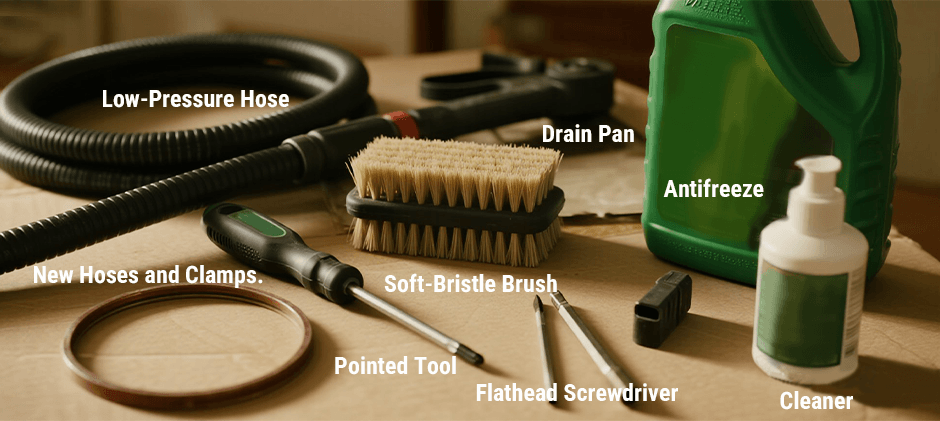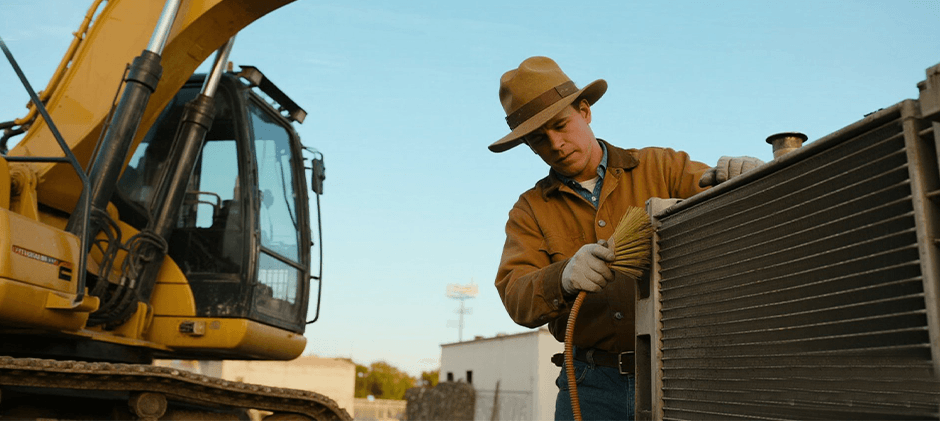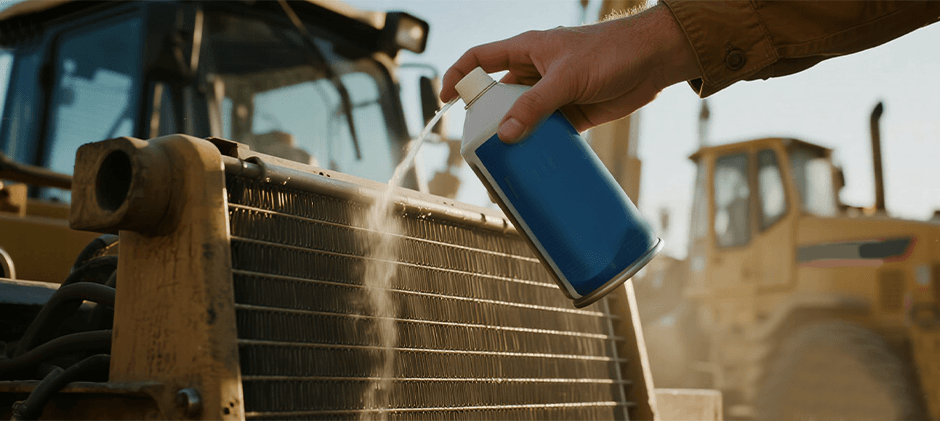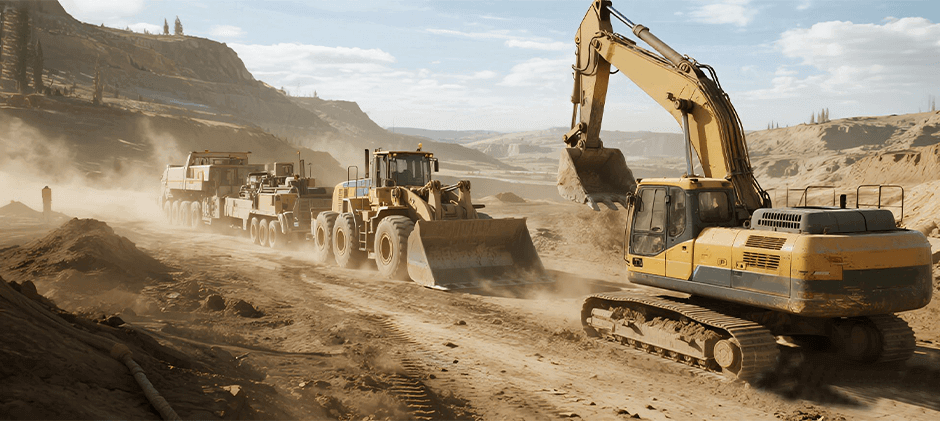The Best Way to Clean a Radiator
The engine serves as the core of any off-road machine, whether it is a tractor, a loader, or an excavator. The engine radiator is the unsung hero that keeps that engine running at its best, especially under the severe demands of off-road operation. It is estimated that a sizable portion, between 40% and 60%, of engine failures are directly related to cooling system problems, which result in expensive downtime and lower productivity.
The best way to clean a radiator for off-road machinery involves a comprehensive approach that addresses both external fin cleaning and internal system flushing.
- Regular External Cleaning: This involves gently removing debris from radiator fins using methods like soft-bristle brushes and compressed air to ensure optimal airflow. Engine-safe cleaners can be used to remove stubborn grime, followed by a low-pressure rinse.
- Thorough Internal Flushing: Periodically flushing the cooling system removes accumulated rust, scale, and degraded coolant, which can otherwise clog internal passages and reduce efficiency. This process restores the cooling system’s effectiveness and prevents internal corrosion.
For a step-by-step visual guide to engine radiator cleaning, watch the video below, where the FridayParts team demonstrates best practices for effective maintenance.
Alternatively, read this comprehensive guide, and we will walk through the best practices for how to clean a radiator for off-road machinery, covering everything from external fin cleaning to internal flushing, ensuring equipment stays cool and productive.
Preparations When Cleaning
Before undertaking any radiator cleaning or maintenance, safety is paramount. Always ensure the engine is completely off and has cooled to the touch, as hot, pressurized coolant can cause severe injury. Wearing appropriate personal protective equipment, such as gloves and eye protection, is essential. Position the machine on a stable, level surface to prevent any movement during the process. These safety measures not only protect personnel but also prevent damage to the radiator components. For instance, using specialized tools to remove hoses helps avoid breaking soldered joints or damaging hose nipples. Adhering to these steps minimizes the risk of accidental damage to the engine radiator and other cooling system parts.

Gathering the right tools and materials is the next crucial step. You will need:
- A soft-bristle brush.
- A flathead screwdriver (for bent fins).
- A compressed air source (can or compressor with nozzle).
- A low-pressure hose or bucket of clean water.
- Arm & Hammer Washing Soda (for internal flushing) or a professional-grade, engine-safe cleaner/degreaser like Simple Green Pro HD Ready-To-Use Heavy-Duty Cleaner (for external cleaning).
- A drain pan for old coolant.
- A pointed tool for safe hose removal.
- New hoses, clamps, and a thermostat (if replacements are planned).
- Pre-mixed, mineral-free, pH-balanced antifreeze for refilling.
Finally, perform an initial inspection of the radiator and cooling system. Look for any visible damage like leaks, cracks, or rust on the engine radiator. Check the radiator cap for wear or buildup and replace it if damaged. Examine the coolant’s condition; cloudy coolant or visible rust indicates a need for flushing. This proactive assessment helps identify existing issues before they escalate, ensuring a safer and more effective maintenance procedure.
How to Clean Radiator Fins?
In off-road environments, the radiator fins are highly prone to clogging with dust, dirt, grass, and other debris, severely reducing their efficiency. The delicate nature of these fins means that improper cleaning, such as using high-pressure water, can easily deform or flatten them. When fins are bent or damaged, the airflow through the radiator is significantly impeded, directly reducing the surface area available for heat dissipation. This impairment leads to a less efficient cooling system, even if the radiator appears “clean.” For expensive heavy machinery, where cooling demands are immense, even seemingly minor fin damage can lead to a substantial reduction in cooling efficiency, potentially causing engine overheating despite cleaning efforts.
The steps for cleaning radiator fins are outlined below:
- Remove Loose Debris: Gently brush loose dirt downwards with a soft-bristle brush. Then, use compressed air, blowing parallel between the fins, to clear deeper debris. This dry method is preferred.
- Apply Cleaner (for stubborn grime): For caked-on dirt, use an engine-safe cleaner like Simple Green Pro HD, mixed as directed. Avoid harsh chemicals like vinegar or bleach, as they can corrode metals and degrade seals.
- Rinse Gently: Use a low-pressure hose or clean water to rinse the radiator, flushing from the engine side towards the front of the machine. Repeat if the water isn’t clear.
- Straighten Bent Fins: Carefully use a flathead screwdriver or fin comb to gently bend any bent fins back into place, ensuring not to cause further damage.
- Dry: Allow the radiator to air dry completely.
How To Clean Between Radiator Fins
Off-road machinery operating in dusty or debris-filled environments requires regular cleaning between radiator fins, as buildup can quickly obstruct airflow and compromise heat dissipation. Combined with high engine loads and low travel speeds, these conditions significantly increase the risk of overheating if not addressed proactively.
The most effective method for cleaning deep within the radiator fins is:
- Compressed Air: This is the preferred method for clearing debris from the core sections, allowing for targeted removal without physical contact or introducing moisture.
- Caution with Water: While high-pressure water or steam can be used for exceptionally difficult material, compressed air is generally preferred, as high-pressure water can bend or damage the delicate fins, compromising their heat transfer capabilities. If water is necessary, use it with extreme caution and at low pressure, flushing from the engine side towards the front of the machine to push debris out.
Daily inspection of the radiator screen and core for blockages is highly recommended, especially in dusty or warm conditions, to ensure optimal performance and prevent issues before they escalate.
How to Flush a Radiator?
Internal flushing is crucial because coolant degrades over time, becoming acidic and accumulating rust, scale, and contaminants. This internal buildup can clog passages, reduce efficiency, and even mask existing leaks, which may become apparent after cleaning.
The Arm & Hammer Washing Soda method is a proven way to deep clean your radiator and engine block. Here are the steps:
- Drain the System: Carefully remove the lower engine radiator hose, using a specialized tool to avoid damage, and allow all coolant to drain.
- Prepare for Cleaning: Remove the thermostat and temporarily replace its housing to ensure open circulation. Crucially, swap the heater hoses on the engine side; this prepares for back-flushing the heater core later and prevents hose damage. Reinstall the lower radiator hose lightly.
- Initial Cleaning Cycle: Dissolve 1 cup of Arm & Hammer Washing Soda (not baking soda) in water and pour it into the radiator. Fill the system with clean water, ensuring the heater valve is closed. Start the engine and run it at a fast idle for 15-30 minutes, or until the solution turns bright orange.
- Drain and Repeat: Shut off the engine, then carefully remove the lower radiator hose to quickly drain the solution. Allow the engine to cool (30-60 minutes). Reinstall the hose and repeat the cleaning and draining steps until the water runs clean and white.
- Heater Core Flush & Final Rinse: Open the heater valve and let the solution circulate through the heater core for about 30 minutes (the earlier hose reversal ensures backward flushing to prevent clogs). Drain the lower heater hose. Remove both heater hoses from the engine and flush the heater core with fresh water in both directions using a garden hose. Finally, fill the engine with fresh water, run until warm, and drain once more to ensure all cleaning solution is removed.
After flushing, once the engine is cold, it’s highly recommended to replace all radiator, heater hoses, and the thermostat. Refill the system with pre-mixed, mineral-free, pH-balanced antifreeze. Be aware that cleaning can sometimes reveal pre-existing issues like leaks in the water pump or freeze plugs, as the accumulated “crud” might have been temporarily sealing them.
How Often to Flush the Radiator?
The frequency of radiator flushing varies significantly by vehicle type and coolant. For heavy equipment and off-road machinery, the frequency shifts from mileage to operating hours. Older recommendations suggested every 2 years or 600 to 700 hours. With advanced coolant properties, it is now recommended every 5 years or 1200 to 1500 hours. The type of coolant is also a key factor: mineral coolants and semi-synthetics might require annual changes (3-12 months), while fully synthetic coolants are more stable and can last longer, potentially 12-24 months, with some reported cases of up to 7 years under favorable conditions. The most accurate maintenance schedule will always be found in the equipment’s owner’s manual.
Signs indicating a need for a radiator flush include an overheating engine, which is a clear indicator that the cooling system is not functioning correctly. Visible rust or sediment, sludge, grime, or particulates in the coolant reservoir or radiator cap signal that it is time for a flush; the coolant should always be clear. Poor fuel economy can also be a sign of the engine running hotter than usual. For cold climates, checking the coolant frost level, for example, in the fall, is important; if it is near zero, a flush is needed to prevent freezing. An unpleasant odor can also indicate degraded metalworking fluid or coolant.
Radiator Flush Frequency Guide for Heavy Equipment
This table serves as a highly efficient, at-a-glance reference, synthesizing critical data points from multiple sources into a structured, easily digestible format.
| Component/Action | Recommended Frequency (General) | Factors Influencing Frequency | Signs It Is Needed |
|---|---|---|---|
| External Fins Cleaning | Daily inspection, regular cleaning (e.g., weekly/monthly depending on environment) | Dusty/dirty environments, high-load operations | Visible debris, reduced airflow, engine running hotter |
| Internal Radiator Flush | Every 1200-1500 hours or 5 years (for modern coolant) | Coolant type (synthetic vs. mineral), operating hours, severity of use, and manufacturer recommendations | Overheating engine, cloudy/rusty coolant, visible sediment, poor fuel economy |
| Coolant Replacement | Every 1200-1500 hours or 5 years (modern coolant); 3-12 months (mineral/semi-synthetic); 12-24 months (full synthetic) | Coolant type, operating hours, manufacturer recommendations, and signs of degradation | Coolant discoloration, unpleasant odor, reduced cooling efficiency |
| Radiator Cap Check | Regularly (e.g., at each fluid check) | Wear and tear, material buildup | Cracks, damage, loss of pressure |
| Hoses & Clamps Check/Replace | Inspect regularly, replace every 2 years | Age, exposure to heat, expansion/contraction cycles | Excessive softness/hardness, cracks, leaks, loose connections |
How Often Should You Clean the Radiator?
It is also important to differentiate between cleaning the external radiator fins and core, which involves removing dirt and debris, and flushing the internal cooling system, which focuses on removing rust, scale, and degraded coolant. Both are vital but have different frequencies and methods.
For external radiator cleaning (fins and core), a daily visual inspection of the radiator screen and core for debris (dirt, grass, etc.) is highly recommended for off-road machinery, especially in warm or dusty conditions. This proactive check helps maintain optimal performance and prevent overheating. Depending on the severity of the operating environment, external cleaning of the fins and core should be performed regularly. This could range from weekly to monthly for machines operating in very dusty or muddy conditions, or at least annually for general preventive maintenance. Furthermore, if reduced airflow, increased operating temperatures, or visible buildup is noticed, it is time for an immediate external clean, regardless of any set schedule.
For internal radiator flushing, as detailed in the previous section, the frequency depends on operating hours, coolant type, and manufacturer recommendations, typically ranging from 1200-1500 hours or 5 years for modern coolants, or more frequently for older coolants or severe duty.
Which Off-Road Machines Need Radiator Cleaning Often?
Any off-road machine subjected to high loads, dusty conditions, or continuous operation will require diligent and frequent radiator cleaning and maintenance. These machines rely heavily on their cooling systems to prevent overheating and ensure longevity. The direct correlation between a machine’s specific function and operating environment and the heightened criticality of its radiator maintenance needs is evident across various types of heavy equipment. The inherent purpose and typical operating environment of these specific machines, such as excavators, loaders, and tractors, directly expose their engine radiator systems to an accelerated rate of external contamination and internal thermal stress. Machines designed for earthmoving, mining, agriculture, and heavy construction are, by their very nature, operating in environments that rapidly compromise cooling system performance.
This direct and unavoidable link means that for these specific machine types, diligent radiator maintenance is not merely a general best practice but a mission-critical activity. Neglecting it leads to disproportionately higher risks of overheating and subsequent engine failure compared to vehicles in less demanding environments. This communicates that, given what a machine does and where it operates, its radiator is under constant siege, making frequent and thorough cleaning an absolute necessity for its survival and operational success. This deepens the understanding of why the advice is so crucial for specific equipment, emphasizing the economic imperative of diligent maintenance tailored to specific heavy-duty applications.
Common Off-Road Machinery & Radiator Considerations
This table allows operators to quickly identify their specific machine type and understand why radiator maintenance is particularly important for their equipment, given its typical operating environment and the specific challenges it faces.
| Machine Type | Typical Operating Environment | Specific Radiator Challenges | Why Frequent Cleaning is Critical |
|---|---|---|---|
| Excavators | Construction sites, mining, earthmoving (dust, dirt, debris) | High engine loads, continuous digging, and fine particle accumulation in fins | Prevent overheating during prolonged heavy-duty operation, and ensure project timelines |
| Loaders | Quarries, construction, material handling (dust, aggregate, grime) | Exposure to abrasive materials, high heat from hydraulic systems | Maintain lifting/moving efficiency, avoid engine damage from sustained load |
| Tractors | Agricultural fields, farms (dust, plant matter, mud) | Organic debris clogging, variable loads, seasonal extreme temperatures | Ensure reliable operation during critical planting/harvesting seasons, and extend engine life |
| Dozers/Dumpers | Earthmoving, mining (heavy dust, large debris, extreme loads) | Constant exposure to heavy particulates, intense heat generation | Prevent catastrophic engine failure under maximum load, ensure operational continuity |
| Crushers/Screeners | Aggregate processing (extreme dust, fine particles) | Rapid clogging of fins, potential for abrasive wear | Maintain processing efficiency, prevent overheating in stationary, high-output operations |
| ATVs/UTVs (Heavy Duty) | Trails, farms, recreational (mud, sand, dust, water crossings) | Variable terrain, exposure to diverse contaminants, potential for submerged radiators | Ensure reliable performance for recreational or utility tasks, and prevent engine seizing |
Conlcusion
The radiator functions as the lifeline of off-road machinery, diligently working to dissipate the immense heat generated under demanding conditions. Neglecting radiator maintenance, encompassing both external radiator cleaning and internal flushing, is a primary driver of engine failure and costly downtime for heavy equipment.
Effective radiator cleaning is not merely a standalone task but an integral part of a comprehensive cooling system maintenance strategy. This strategy includes regular coolant checks, timely hose replacements, and thorough thermostat inspections. By understanding the unique challenges posed by off-road environments and diligently implementing the detailed cleaning and flushing methods outlined, operators can significantly extend the life of their equipment, maintain optimal performance, and ensure their machinery is always ready for the toughest jobs. Make regular radiator cleaning and cooling system checks a non-negotiable part of any maintenance routine. Investing in these practices contributes directly to the longevity and efficiency of valuable off-road assets. For quality replacement parts like an engine radiator, visit the FridayParts Cooling System Components collection for more information.



